

Claim-Evidence-Reasoning. Designing Science Inquiry: Claim + Evidence + Reasoning = Explanation. In an interview with students, MIT's Kerry Emmanuel stated, "At the end of the day, it's just raw curiosity.

I think almost everybody that gets seriously into science is driven by curiosity. " Curiosity -- the desire to explain how the world works -- drives the questions we ask and the investigations we conduct. Let's say that we are planning a unit on matter. By having students observe solids and liquids, we have helped them define matter as something that has mass (or weight -- don’t worry about the difference with elementary kids!) And takes up space. Is air matter? Next, we can ask our students what data they need to answer the question, and how they can collect that data -- how they can investigate.
Why Does Inquiry Matter? Focuses on understanding what inquiry is, why we should care about it, and how inquiry fits into the teaching and learning of science© 2006This complimentary 35-page PDF booklet is available at the BSCS eStore One of the greatest challenges is trying to understand what inquiry is.
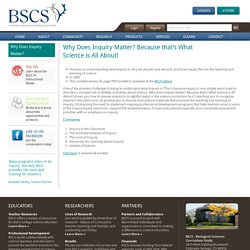
This is because inquiry is one simple word used to describe a complex set of abilities and ideas about science. Why Does Inquiry Matter? Because that’s What Science is All About! Shows you how to elevate inquiry to its rightful status in the science curriculum by (1) teaching you to recognize inquiry in the classroom; (2) guiding you to choose instructional materials that promote the teaching and learning of inquiry; (3) stressing the need to implement ongoing professional development programs that help teachers enact a vision of the inquiry-based classroom, support the implementation of new instructional materials, and coordinate assessment priorities with an emphasis on inquiry. Why Inquiry Learning is Worth the Trouble. Visualization of SLA principal Chris Lehmann's 2011 talk: guiding kids' to thinking about how they think.
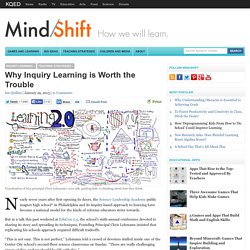
Nearly seven years after first opening its doors, the Science Leadership Academy public magnet high school* in Philadelphia and its inquiry-based approach to learning have become a national model for the kinds of reforms educators strive towards. But in a talk this past weekend at EduCon 2.5, the school’s sixth-annual conference devoted to sharing its story and spreading its techniques, Founding Principal Chris Lehmann insisted that replicating his schools approach required difficult tradeoffs. “This is not easy. This is not perfect,” Lehmann told a crowd of devotees stuffed inside one of the Center City school’s second-floor science classrooms on Sunday.
“There are really challenging pieces of this, and we should be OK with this.” Scientific Inquiry & Education - NSTA Position Statements. Introduction The National Science Education Standards (NSES p. 23) defines scientific inquiry as "the diverse ways in which scientists study the natural world and propose explanations based on the evidence derived from their work.

The Five Features of Science Inquiry: How do you know? Teaching science through science inquiry is the cornerstone of good teaching.
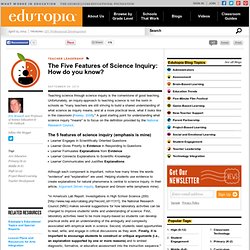
Unfortunately, an inquiry-approach to teaching science is not the norm in schools as "many teachers are still striving to build a shared understanding of what science as inquiry means, and at a more practical level, what it looks like in the classroom (Keeley, 2008). " The Challenges and Realities of Inquiry-Based Learning. Inquiry Learning Teaching Strategies Getty By Thom Markham.
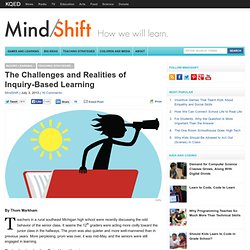
Inquiry Learning Vs. Standardized Content: Can They Coexist? By Thom Markham As Common Core State Standards are incorporated from school to school across the country, educators are discussing their value.
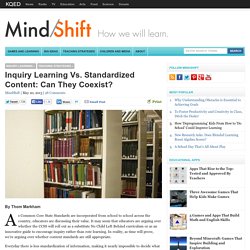
It may seem that educators are arguing over whether the CCSS will roll out as a substitute No Child Left Behind curriculum or as an innovative guide to encourage inquiry rather than rote learning. In reality, as time will prove, we’re arguing over whether content standards are still appropriate. Everyday there is less standardization of information, making it nearly impossible to decide what a tenth-grader should know. Beyond the core literacies of reading, writing, computation, and research, the world-wide culture of innovation, discovery, multi-polarity, interdisciplinary thinking, and rapid change depends on the explosive potential of the human mind, not entombed truths from the past.
Creating Classrooms We Need: 8 Ways Into Inquiry Learning. If kids can access information from sources other than school, and if school is no longer the only place where information lives, what, then happens to the role of this institution?

“Our whole reason for showing up for school has changed, but infrastructure has stayed behind,” said Diana Laufenberg, who taught history at the progressive public school Science Leadership Academy for many years. Laufenberg provided some insight into how she guided students to find their own learning paths at school, and enumerated some of these ideas at SXSWEdu last week. 1. BE FLEXIBLE. The less educators try to control what kids learn, the more students’ voices will be heard and, eventually, their ability to drive their own learning. Laufenberg recalled a group of tenacious students who continued to ask permission to focus their video project on the subject of drugs, despite her repeated objections. 2.
Laufenberg’s answer: Get them curious enough in the subject to do research on their own. 3.